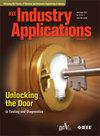Ground Fault Location Method for Catenaries of DC Railway Systems
IF 4.2
2区 工程技术
Q2 ENGINEERING, ELECTRICAL & ELECTRONIC
引用次数: 0
Abstract
The utilization of Direct Current (DC) railway systems is increasingly prevalent, as it constitutes the majority of urban tram power supply systems. Despite their high efficiency, the risk of ground faults is ever-present due to environmental issues and aging of the catenaries. These faults can interrupt the service for hours until repaired, requiring quick repair. To address this issue, this paper introduces a ground fault location method for catenaries in DC railway systems, based on the measurement of the DC voltage and ground current at each DC Traction Substation (TS). Then, the normalized ground currents relative to the overall fault current are compared with a model-based data pool, enabling the method to locate the fault along the protected catenary. The method's validity has been confirmed through numerous simulations and experimental tests. Initially, simulations were conducted on a three-TS DC railway model in Matlab-Simulink, yielding promising results. Subsequently, experimental laboratory tests were performed using uncontrolled rectifiers in the TS, also producing encouraging results. Finally, the suitability of the fault location method was verified using Hardware-In-the-Loop (HIL) tests emulating controlled rectifiers.直流铁路系统接触网接地故障定位方法
直流(DC)铁路系统的使用越来越普遍,因为它构成了大多数城市有轨电车供电系统。尽管它们的效率很高,但由于环境问题和接触网的老化,地面故障的风险始终存在。这些故障可以中断服务数小时,直到修复,需要快速修复。为了解决这一问题,本文介绍了一种基于直流牵引变电所直流电压和接地电流测量的直流铁路系统接触网接地故障定位方法。然后,将归一化接地电流相对于总体故障电流与基于模型的数据池进行比较,使该方法能够沿保护接触网定位故障。通过大量的仿真和实验验证了该方法的有效性。首先,在Matlab-Simulink中对三ts直流铁路模型进行了仿真,得到了令人满意的结果。随后,在TS中使用不受控制的整流器进行了试验性实验室测试,也产生了令人鼓舞的结果。最后,通过仿真可控整流器的硬件在环(HIL)测试,验证了故障定位方法的适用性。
本文章由计算机程序翻译,如有差异,请以英文原文为准。
求助全文
约1分钟内获得全文
求助全文
来源期刊

IEEE Transactions on Industry Applications
工程技术-工程:电子与电气
CiteScore
9.90
自引率
9.10%
发文量
747
审稿时长
3.3 months
期刊介绍:
The scope of the IEEE Transactions on Industry Applications includes all scope items of the IEEE Industry Applications Society, that is, the advancement of the theory and practice of electrical and electronic engineering in the development, design, manufacture, and application of electrical systems, apparatus, devices, and controls to the processes and equipment of industry and commerce; the promotion of safe, reliable, and economic installations; industry leadership in energy conservation and environmental, health, and safety issues; the creation of voluntary engineering standards and recommended practices; and the professional development of its membership.
 求助内容:
求助内容: 应助结果提醒方式:
应助结果提醒方式:


